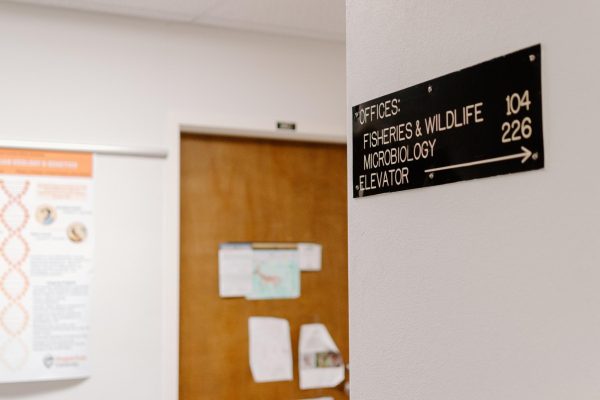Food pantries urge Corvallis residents to save food stamps, rent money, take advantage of free food services
December 29, 2020
Food banks and pantries in Corvallis continue to be available for those facing food insecurity, with modifications in place to distribute resources safely.
Since the pandemic began, the St. Vincent de Paul Food Pantry provides boxes of food for clients to pick up.
For those facing food insecurity, Kim Anderson, purchasing agent for the pantry, said people can visit the distribution area outside the building to pick up food, with the help of volunteers. She noted that everyone who visits the pantry must wear a mask.
“Now, they do have some choice in what they can get, but basically it’s a standardized box of necessary items – three or four days-worth of food, per person,” Anderson said.
The St. Vincent de Paul Food Pantry offers people fresh milk, cheese, fresh vegetables, protein and meats, as well as canned and dried food. People can visit the pantry once a month, though Anderson noted they will not turn someone away who needs more food before a month has passed.
Due to the pandemic, food bank and pantry organizers encourage community members to donate money rather than bring in canned foods from home.
In addition to their food pantry boxes, St. Vincent de Paul sets up a drive-in food pantry once a month on a Saturday. This used to be hosted at Garfield elementary school, but due to reconstruction, has been moved to St. Mary’s church.
St. Vincent de Paul is open Monday, Wednesday, and Friday from 1:30 p.m. to 4:00 p.m. These hours, Anderson said, are not ideal for working families, so having a drive-in food pantry once a month on a Saturday helps them out.
Typically over 50 families are served on that single Saturday, said Anderson.
Like the St. Vincent de Paul Food Pantry, the South Corvallis Food Bank offers an emergency food box and weekly resources.
According to Sheila O’Keefe, executive director, the food bank provides a five-day supply of food once per calendar month to anyone who is low-income and in need of food. Customers can also visit weekly for fresh produce, bread and a few extras.
The food bank has moved their check-in outside and switched from a shopping style to a prepacked box of shelf-stable items. Customers do still get to choose their refrigerated and frozen items, O’Keefe noted.
“Everyone must wear a mask and maintain social distance while at the food bank,” O’Keefe said. “We have free masks for anyone needing one.”
For those who are members of a vulnerable population due to age or health issues and those who are self-isolating or quarantining, O’Keefe said the food bank offers delivery via Dial-a-bus.
Nicole Hindes, director of the Human Services Resource Center at Oregon State University, said the HSRC provides many resources for people facing food insecurity.
On campus, Hindes said the HSRC provides two food support programs.
“One happens every Wednesday, where students can come by and they can get some basics,” Hindes said. “That might include flour, or masa, or chicken, or tofu. It might include canned corn or lentils or beans or pasta or rice. It’s a meaningful quantity of food and it’s a great resource for students.”
Students can visit the HSRC, located in Champinefu Lodge, on Wednesdays between 10:00 a.m. and 3:00 p.m. to be served by this program on the back porch of the building
The second food support program is Healthy Beaver Bags, which occurs every Friday from noon to 2:30 p.m., also on the back porch of Champinefu Lodge.
“This is a bag of groceries around a theme,” Hindes said. “It always includes eggs and yogurt, unless someone opts out, and then the other ingredients are helpful for a themed recipe. So, every Friday we post on our Instagram what the theme is, along with a picture of what the ingredients are.”
The HSRC also provides help to students applying for the Supplemental Nutrition Assistance Program, commonly known as food stamps, which can help students afford more money for groceries.
“We’ll meet with a student one-on-one,” Hindes said. “This can happen remotely, so this is something where someone who is two states away can meet with my staff, and we can help them apply for SNAP in the state that they are.”
Due to the pandemic, the HSRC now works with the Valley Library to provide textbooks in a digital format. Additionally, the HSRC is the point of contact for students who want to check out laptops, hotspots, or similar resources.
Hindes said that though these programs may not be food insecurity resources, textbook and laptop support might help a student adjust their budget and be able to afford food.
She noted that the HSRC has generally seen a steady incline of people coming to the HSRC for food support.
To their surpise, the St. Vincent de Paul Food Pantry and South Corvallis Food Bank experienced opposite trends – in the immediate aftermath of the pandemic, the number of visits to their facilities decreased.
“For the first four to six months of the pandemic, the number of clients that we served actually declined by as much as 20%,” Anderson said. “There’s a couple reasons for that: one was the $1200 check that was sent out by the federal government and also food stamps allotments were increased, so people were getting more food stamps and there was less need.”
Now, Anderson said the number of clients they serve has returned to pre-pandemic levels. They now help approximately 700 to 950 people per month, or 200 to 250 families.
In his opinion, Anderson thinks people should have saved their food stamps and used their food pantry instead, though he understands why people would prefer to visit grocery stores and pick out exactly what they want.
O’Keefe shared similar data regarding the number of clients who used the South Corvallis Food Bank. She said they are down approximately 25% of clients from their pre-pandemic levels.
“According to Linn Benton Food Share, this is the case for most of the pantries in the two-county area they serve,” O’Keefe said. “We assume this has been due to extra government benefits and new programs such as the school district delivering food. We worry that some clients who rent their homes are misunderstanding the eviction moratorium and using their rent money to buy food. The eviction moratorium does not mean free rent. When the moratorium expires, tenants will have to pay all their back rent or face eviction.”
The St.Vincent de Paul Food Pantry is still accepting volunteers to help stock and move food deliveries. Anderson said they are a completely volunteer-run facility and appreciate any community support they receive.
O’Keefe added that if anyone would like to shop for the food bank or run a food drive, the most-needed items can be found on their website.
“Like so much of the country, the food distribution system that supplies us with most of our food has had problems this year, occasionally leading to shortages of staples,” O’Keefe said. “Many generous community members have shopped for us to fill those holes. We’re very grateful to them.”

























































































































